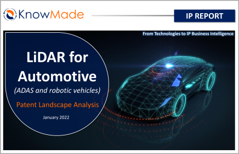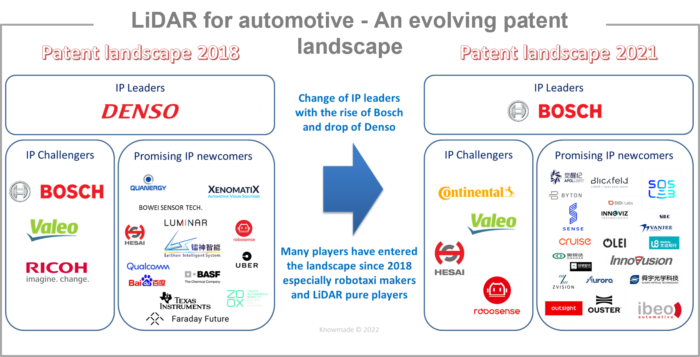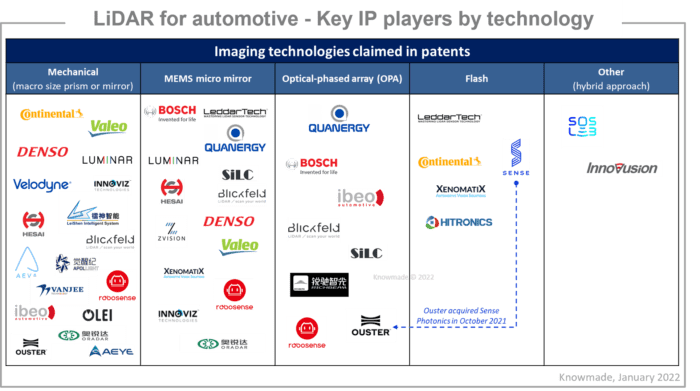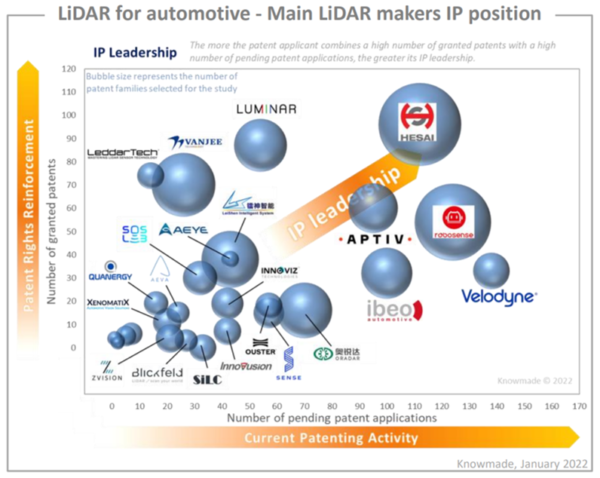
Who are the key LiDAR players and what recent IP developments strategies are they adopting?
Publication January 2022
| Download Flyer | Download Sample |
Report’s Key Features

- PDF with > 140 slides
- Excel file > 11.900 patent families + hyperlink to updated online database (legal status, documents etc.)
- IP trends, including time evolution of published patents and countries of patent filings.
- Ranking of main patent assignees.
- Newcomers in the IP landscape.
- Patent categorization by type of LiDAR (mechanical, MEMS micromirrors, OPA, flash, ToF, FMCW, phase-shift, etc.).
- IP position of key players, and relative strength of their patent portfolios.
- Current main technological approaches.
- IP profiles of 35+ key players (tier one suppliers, LiDAR pure players, robotaxi/autonomous vehicle makers), including IP dynamics, legal status and geographical coverage of patents, IP strategies, key patents and recent IP developments.
- Excel database with all patents analyzed in the report, including technology segmentation and hyperlinks to an updated online database.
More KnowMade patent landscapes on MEMS sensors. We regularly produce patent landscapes because of their benefits for intellectual property decision-makers in many scientific fields.
The LiDAR-related patent landscape is very dynamic, with numerous newcomers
Over the last 7 years, the automotive industry has strongly believed that LiDAR would be one of the key sensors to develop high-level Advanced Driver Assistance Systems (ADAS) and 3D mapping solutions, unlocking the door to autonomous vehicles and robotaxis. Today, the market for LiDAR in automotive is divided between ADAS and robotic vehicles. Both applications show a high expected compound annual growth rate (CAGR) of 111% and 33% respectively over the 2020-2026 period, according to Yole Développement’s report. Players that can provide automotive-grade LiDAR with advanced 3D mapping would be in a good position to take a nice slice of the million-dollar cake. Being able to protect their position with strong intellectual property (IP) can be a big asset in this highly competitive industry.
In this context, Knowmade is releasing a new patent landscape report covering the whole supply chain of LiDAR for automotive applications, from electronic components, optical systems and LiDAR devices to systems using LiDAR and computing. Patent landscape analysis is the perfect complement to market research, to fully comprehend the competitive landscape and technology roadmap, keep up with new technology developments, anticipate future technology adoption, and understand the different competitors’ strategies. This kind of patent landscape report reveals the companies, technical solutions and strategies not identified through standard market analysis.

The intellectual property (IP) landscape also confirms the strong enthusiasm for LiDAR. Indeed, since 2018 we have witnessed the entrance of many LiDAR pure players that contribute to the very strong acceleration in patenting activity. Furthermore, the low number of academics among patent applicants attests to the maturity of the technology. These players are today competing against well-established tier one suppliers that benefit from their early activity related to low-level ADAS systems back in the 2000s.
The strong competition has already led to significant changes in the LiDAR-related patent landscape over the last 2 years. Indeed, Denso lost its leading IP position to Bosch. Chinese LiDAR pure players Hesai Technology and Robosense became the new IP challengers, while many smaller IP players just entered the game or closed the gap. In addition, as the LiDAR automotive market is just beginning to grow, many collaborations are occurring, and mergers and acquisitions (M&A) may happen to consolidate the players’ market and IP position.
LiDAR-related patents published worldwide and covering the whole value chain
Knowmade’s analysts have selected and analyzed more than 24,000 patent applications published worldwide up to July 2021 and corresponding to 11,900+ patent families (inventions) related to LiDAR for automotive applications (ADAS and robotic cars). This report includes patents describing LiDAR components (laser, lenses, mirrors, etc.), LiDAR devices and systems using LiDAR (anticollision system, autonomous vehicles, 3D mapping systems, etc.). We have identified more than 2,000 different patent assignees involved in the LiDAR for automotive.
IP players’ positions, current developments & IP strategies
The report provides a clear overview of the most active patent applicants as well as a presentation of newcomers to the patent landscape. Furthermore, patent segmentation reveals the IP position of patent assignees by LiDAR technology. The IP landscape analysis shows that where major IP players are involved, the competition is mainly focused on mechanical LiDAR. In addition, recent inventions indicate that LiDAR is a mature technology where the main innovations are no longer related to LiDAR itself but to LiDAR assembly, as well as control or calibration methods. Technologies providing embedded software to reduce interference and parasitics (including environmental hazards) and maintain LiDAR performance in all conditions are the main technologies described in recent patent applications. Despite their advantages and promises, solid-state LiDAR solutions (OPA, flash) remain very small IP segments where a limited number of IP players are competing.

Focus on key players’ patent portfolios
The report provides a detailed analysis of 36 key IP players and most promising IP newcomers: Bosch, Denso, Valeo, Continental, Quanergy, LeddarTech, XenomatiX, Luminar, Velodyne, LeiShen, Hesai, Robosense, Ibeo, Ouster, Sense Photonics, Aptiv, Innoviz, Aeva, Aeye, Innovusion, SOSLAB, Zvision, SiLC, Oradar, Blickfeld, Richbeam, Apollight, Hitronics, Olei, Vanjee, Waymo, Baidu, Uber, Cruise, Zoox and Aurora. For each player, we summarize their IP portfolio and key patents, make the links between patents and products to highlight the protected LiDAR systems, and unveil their IP strategies by analyzing their recent patents and IP collaborations.
Understand the current dynamics and technological trends
Current patenting activities, geographical coverage and technological segments are analyzed. In this report, Knowmade highlights the main technical challenges faced by the industry to enhance the LiDAR and sensing systems’ performances. The report focuses especially on LiDAR architecture and hardware solutions such as optical path arrangements, VCSEL array and detector arrangements. Methods to drive the emitter to enhance the LiDAR field of view, reduce power consumption or enhance detector sensitivity are described.
Useful Excel patent database
The report also includes an Excel database with the 11,900+ patent families (inventions) analyzed in this study. This useful patent database allows for multi-criteria searches and includes patent publication numbers, hyperlinks to an updated online database (original documents, legal status, etc.), priority dates, title, abstract, patent assignees, patent’s current legal status, and segments (mechanical, MEMS micromirrors, OPA, flash, ToF, FMCW, phase shift, etc.).
Companies mentioned in the report (Non-exhaustive)
Bosch, Denso, Mitsubishi, Nissan, Toyota, Sick, Daimler, Omron, General Motors, Valeo, Ford, Honda Motor, Hyundai, Continental, Mazda Motor, Sanyo, Ricoh, BMW, Daihatsu, Waymo, Hitachi, Volkswagen, Xenomatix, NEC, Panasonic, Google, Audi, Nikon, Fujitsu, Changan University, Omron Automotive Electronics, Kansei, Ibeo Automotive, Volvo, Chery Automobile, Shenzhen Leishen Intelligent Systems, Raytheon, Sharp, Hokuyo Automatic, Shiny Technology, Uber, Nippon Soken, Velodyne, Qualcomm, Shanghai Slamtec, BASF, Philips, Fraunhofer, Zoox, Quanergy Systems, Apple, Texas Instruments, LG Innotek, Scania, Qinetiq, Luminar Technologies, Hesai Photonics, Robosense, AEYE, AEVA, HITQZ, Richbeam, Fexa, Nvidia, Huawei, Nuro, Pony AI, Vanjee, Innovusion, Blickfeld, Aptiv, etc.
